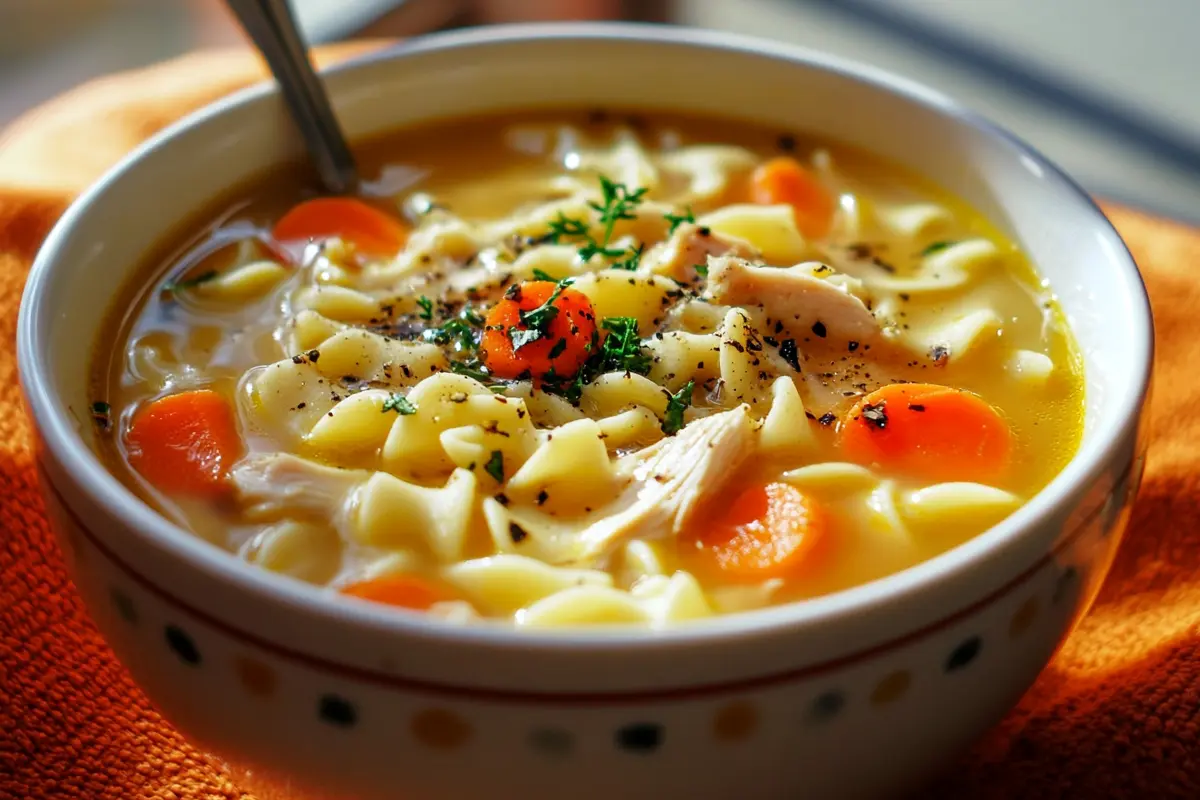
Introduction of Creamy Chicken Noodle Soup
Creamy chicken noodle soup is a timeless dish, bringing comfort to homes worldwide. It’s a rich, savory blend of tender chicken, noodles, and velvety broth, making it an ideal choice for chilly days, cold recovery, or simply a wholesome family meal. Unlike the classic clear broth version, this variation uses milk or cream, offering a richer, more satisfying flavor. In this article, we’ll explore the fascinating origins of this beloved recipe, its ingredients, and how you can create it at home. We’ll also include tips for variations, storage, reheating, and serving suggestions.
History of Creamy Chicken Noodle Soup
Chicken noodle soup has a rich heritage dating back to ancient China, where noodle soups were part of everyday diets. The concept then spread to other Asian regions and Europe, evolving along the way. In the U.S., chicken noodle soup became popular during the 20th century, thanks to the rise of canned soups. The creamy version, which includes milk or heavy cream, emerged as a variation during the mid-20th century, adding a richer texture and flavor to the traditional recipe. This version quickly became a favorite in American households and inspired variations across Europe, Latin America, and even parts of Asia.
Ingredients for Creamy Chicken Noodle Soup
Essential Ingredients:
- Chicken Breast or Thighs: For a rich, tender bite.
- Egg Noodles: Classic, wide egg noodles are preferred, but any noodle works.
- Carrots, Celery, and Onions: Essential vegetables that provide depth of flavor.
- Chicken Broth or Stock: Provides a savory base for the soup.
- Garlic and Herbs (Thyme, Parsley, Bay Leaves): Add warmth and aroma.
- Heavy Cream or Whole Milk: Adds the creamy texture.
- Butter and Flour: Combined to make a roux, which serves as a thickening agent for the soup.
Substitutions:
- Chicken: Use rotisserie chicken or turkey for a quicker option.
- Noodles: Substitute with gluten-free noodles or spiralized vegetables for a low-carb alternative.
- Heavy Cream: Use coconut milk for a dairy-free version or half-and-half for a lighter option.
- Butter: Replace with olive oil for a dairy-free option.
Cooking Instructions
Preparation:
- Prep the Ingredients: Dice the chicken into bite-sized pieces, chop the vegetables, and measure out the other ingredients.
Step-by-Step Cooking:
- Cook the Chicken: In a large pot, heat butter over medium heat. Add chicken and sauté until golden brown. Transfer the cooked chicken from the pot to a separate dish and set it aside.
- Cook the Vegetables: Add onions, carrots, and celery to the pot. Sauté for 5-7 minutes until vegetables are soft.
- Add the Broth: Pour in the chicken broth, bringing the mixture to a boil. Add bay leaves and thyme.
- Make the Roux: In a separate small saucepan, melt butter and add flour, stirring constantly until golden brown. Slowly whisk in heavy cream or milk until smooth.
- Add Roux to the Soup: Pour the roux into the pot, stirring well to combine. Add the chicken back into the pot.
- Cook the Noodles: Add noodles to the pot and let them cook for about 8-10 minutes or until tender.
- Season and Serve: Adjust seasoning with salt, pepper, and fresh parsley. Serve hot with a sprinkle of fresh herbs.
Cooking Tips:
- Timing: Cook for about 30-35 minutes, allowing all flavors to meld.
- Noodle Texture: Add noodles during the last 10 minutes of cooking to avoid overcooking.
Variations
- Spicy Chicken Noodle Soup: Add chili flakes or hot sauce for a spicy kick.
- Vegetarian Option: Substitute chicken with chickpeas or tofu and use vegetable broth.
- Asian-Inspired Creamy Chicken Noodle Soup: Add soy sauce, ginger, and sesame oil for an Asian twist.
- Mushroom & Chicken Noodle Soup: Add sliced mushrooms for an earthy flavor.
- Herb-Infused: Add fresh rosemary, sage, or tarragon for a different herbal flavor.
Storage and Reheating Tips
Storing Leftovers:
- Refrigeration: Store in an airtight container in the refrigerator for up to 4 days.
- Freezing: The soup can be frozen for up to 3 months. It’s best to freeze without noodles, as they can become mushy when reheated.
Reheating:
- Stovetop: Reheat over medium heat, stirring occasionally until warmed through.
- Microwave: Heat in a microwave-safe bowl in 1-minute intervals, stirring in between.
- Thickening the Soup: If the soup has thickened too much, add a splash of broth or water to restore its consistency.
Serving Suggestions
- Bread Pairings: Serve with warm garlic bread, crusty sourdough, or buttery biscuits for a filling meal.
- Salad Pairings: Pair with a fresh Caesar salad or a simple green salad for a balanced meal.
- Garnishes: Top with fresh herbs, a dollop of sour cream, or grated parmesan for an extra touch of flavor.
FAQs
- Is it possible to prepare creamy chicken noodle soup in a slow cooker?
- Yes, you can! Cook the vegetables and chicken on low for 6-8 hours or on high for 3-4 hours. Add the noodles during the last 30 minutes of cooking and stir in the cream before serving.
- How can I make the soup gluten-free?
- Use gluten-free noodles and replace the flour with cornstarch or a gluten-free flour blend for thickening.
- What’s the best way to reheat creamy chicken noodle soup without curdling?
- Reheat slowly over medium-low heat and avoid boiling, as this can cause the cream to separate.
- Is it okay to use leftover rotisserie chicken in this recipe?
- Absolutely! Simply shred the cooked rotisserie chicken and add it during the last 10 minutes of cooking.
- Is it possible to make this recipe dairy-free?
- Yes, you can substitute the cream with coconut milk and the butter with olive oil or dairy-free margarine.
Health Benefits of Creamy Chicken Noodle Soup
Creamy chicken noodle soup isn’t just a comforting dish—it also comes with several health benefits. Here’s why adding it to your meal rotation can be good for you:
- Rich in Protein:
- Chicken is a great source of lean protein, crucial for muscle growth, immune support, and overall body repair.
- Protein also helps you feel fuller for longer, reducing the urge to snack between meals.
- Boosts Immunity:
- The warm broth can help soothe sore throats and ease nasal congestion, making it a popular remedy during cold and flu season.
- Garlic, onion, and herbs like thyme and parsley contain antioxidants that support immune health.
- Nutrient-Packed Vegetables:
- Carrots, celery, and onions are loaded with essential nutrients, such as vitamins A, C, and K, as well as potassium and dietary fiber.
- These nutrients promote eye health, improve digestion, and reduce inflammation.
- Hydration:
- Soups are high in water content, which keeps you hydrated. Maintaining proper hydration is crucial for supporting healthy skin, lubricating joints, and ensuring optimal body functions.
- Digestive Support:
- The warm, smooth texture of the soup is gentle on the stomach and can aid digestion, making it a great option for those with sensitive stomachs.
- The presence of fiber from vegetables and herbs promotes gut health and regular bowel movements.
- Calcium for Bone Health:
- If you use milk or cream, it adds calcium to the dish, which supports strong bones and teeth.
- Anti-Inflammatory Properties:
- Ingredients like garlic, parsley, and carrots contain compounds that help reduce inflammation in the body, making it beneficial for managing chronic conditions like arthritis.
- Energy Boost:
- The carbohydrates from noodles provide a quick source of energy, making the soup a perfect post-workout meal or a mid-day pick-me-up.
- Mood-Enhancing Effects:
- Chicken contains tryptophan, an amino acid that helps the body produce serotonin, a mood-boosting neurotransmitter. This is why chicken noodle soup can also help improve your mood and reduce stress.
Tips to Make It Healthier
- Use whole-grain noodles for added fiber and nutrients.
- Add more vegetables like kale, spinach, or broccoli to boost vitamin intake.
- Choose low-sodium broth to reduce sodium content and maintain heart health.
- Replace heavy cream with Greek yogurt or low-fat milk for a lighter option with more protein.
Conclusion
Creamy chicken noodle soup is a comforting dish that is as satisfying to make as it is to eat. Its rich history and versatile nature make it a staple in many households. Whether you’re seeking a warm meal on a cold day or a soothing dish when feeling under the weather, this creamy delight is always a winner. Try making it at home and experiment with the suggested variations to suit your personal taste. Enjoy this comfort classic!

